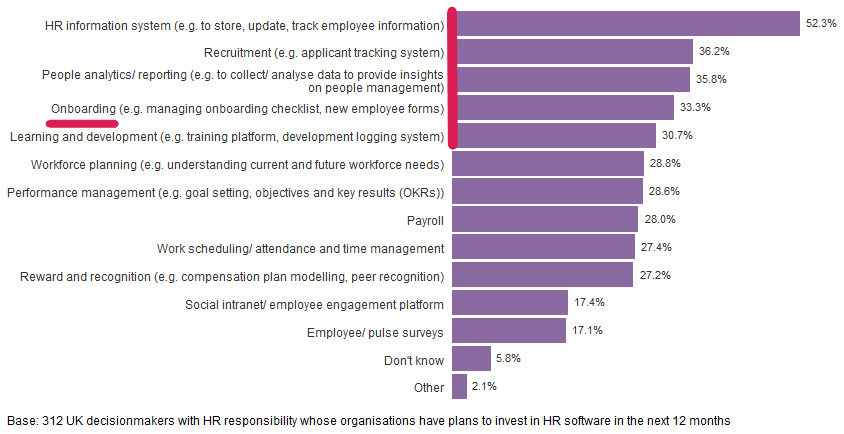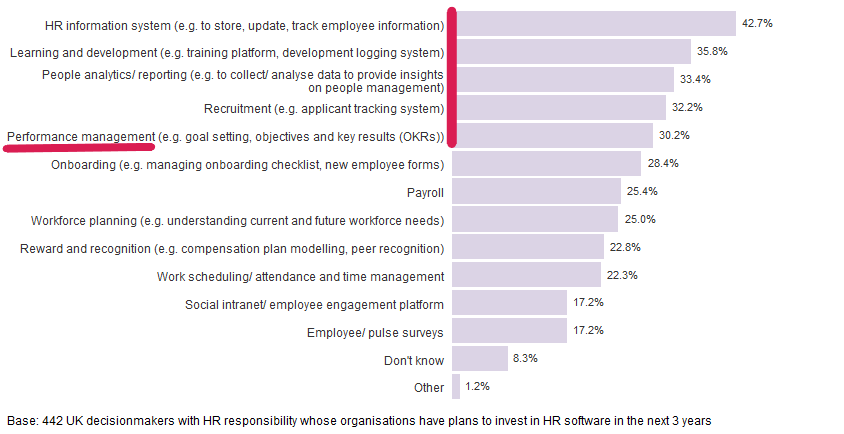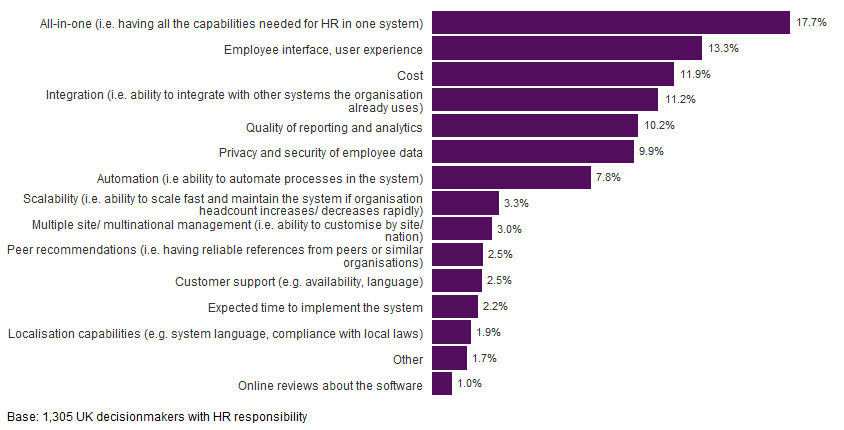
Future of workforce reporting
Based on an assessment of FTSE 100 annual reports and focus groups with investors and HR leaders, this report gives benchmarking data, insights and practical recommendations for improving workforce reporting practices
Business focuses are shifting towards the longer term and investment in software will be key
From a list of 20 options, we asked bosses to choose up to three areas they considered a business focus for the past as well as the next 12 months. The options, displayed in random order, included:
They also had the option to say they didn’t know or to state another business focus.
Comparing what has happened with what is anticipated to happen (Figures 1 and 2), we can see the disruptions caused by the pandemic has influenced priorities.
Figure 1: Top five business focus in the last 12 months (Jun-Aug 2021 to Jun-Aug 2022)

Figure 2: Top five business focus in the next 12 months (Jun-Aug 2022 to Jun-Aug 2023)

While four of the five most common business focus areas remain unchanged, the percentages for some have fallen significantly as attention shifts to other areas. For example, recruitment/talent acquisition in the last 12 months was a priority to more bosses in our survey (27.3%) than it’s expected to be in the next 12 months (22%). As seen in the media, restaurants, hotels, night clubs and other businesses that temporarily closed or let go of people during the pandemic scrambled to recruit when social distancing measures gradually lifted in the UK in 2021.
Optimising remote and hybrid working was a top five business priority over the last 12 months but not for the next 12 months, as people who can work from home adjust to their post-pandemic work routines. This focus saw the largest fall of 8.8 percentage points, down to 9.8%.
Because attention has shifted away from these and more bosses were uncertain about future business focus areas, organisation culture climbed from sixth to fourth most common business focus area for the next 12 months.
For the next 12 months, priorities appear to be shifting towards longer term goals for some bosses. The largest increase in focus is in building a sustainable and responsible business (up 3.2 percentage points to 13.2%). This is a top five business focus area for those in the manufacturing industry.
Over one in ten bosses (12%) didn’t know what their organisations’ business focus might be in the next 12 months. This rises to one in five (19.9%) among those at the junior manager/team leader/supervisor level, suggesting that their organisations may have been unclear about business priorities or have not communicated these to them.
Specifically, we were interested to see how investment in HR software was being considered as a business focus. So we asked bosses if they had plans to invest in HR software (Figure 3). Investment here could include, buying, upgrading, replacing or adding new features to existing software.
Figure 3: Is your organisation planning to invest in HR software? 
More bosses said their organisations have plans to invest in HR software in the next three years (35.6%) than in the next 12 months (26.5%). Those who said so were more likely from large organisations (over 250 employees worldwide) than from medium-sized organisations (50 to 250 employees worldwide).
Reducing cost, simplifying work and rapid growth were some of the reasons given by those whose organisations have plans to invest in HR software in the next 12 months and three years. For those whose organisations have no plans to invest in HR software, some said it’s because their HR software is relatively new or that it’s a low priority.
Four in ten (40.6%) didn’t know if their organisations have plans to invest in HR software in the next three years. Those who said that tended to be ones with HR decision-making responsibilities but don’t work within an HR function, are in lower management levels or work in the public or third sectors. Decisions to invest in HR software in public sector organisations like the NHS, civil service and schools are normally decided centrally.
An HR information system (HRIS) is the most cited investment priority for those who do have plans to invest in HR software over the next 12 months and three years (Figures 4 and 5). This is because having a good HRIS is essential for efficient HR administration as the organisation evolves. Many HRISs these days do more than just store, update and track employee information. They can include other features such as people analytics, performance management and employee surveys.
Figure 4: Which of the following types of HR software are priorities for investment over the next 12 months? 
Figure 5: Which of the following types of HR software are priorities for investment over the next three years?

Over the next 12 months, the second and fourth most cited investment priority are recruitment and onboarding software. These align with recruitment/talent acquisition as a top business focus over the same period (Figure 2).
Looking ahead to the next three years, it appears HR software investment priorities are shifting along the employee lifecycle for some (Figure 5). Investment in learning and development, and performance management software rise to second and fifth place respectively.
Finally, we asked bosses their top three considerations when choosing HR software and to rank them by personal preference. A first choice carries three times the weight of a third choice. Figure 6 shows the CIPD’s analysis of their preferences.
Figure 6: Top considerations when choosing HR software

An all-in-in-one HRIS that has all the capabilities HR needs is the top consideration when choosing HR software. It avoids the added costs of buying more software as well as the complexity of integrating and maintaining several systems. But unless an organisation’s HR requirements are very simple, there’s unlikely to be a single HRIS that meets all of those needs today. Recognising this need, progressive HRIS vendors are expanding their products’ capabilities internally, simplifying integration and acquiring specialist HR software vendors to include within their product offerings.
User experience is another priority consideration. An easy-to-use employee interface is essential if the software is to be used by employees who may not use it every day or are not digitally savvy. Cost comes in third place, followed by the ability to integrate with other systems, the quality of reporting and analytics, privacy and security of employee data, and automation. While peer recommendations and online reviews may be helpful for shortlisting HR software vendors, our findings show these are not the main deal makers or breakers.
Take a look at our partner Hibob’s blogs on why modern businesses need a modern HRIS and how to justify its return on investment.
In the next article, we’ll look at intelligent automation investments made at our respondents’ organisations in the last few years.

Hayfa joined us in 2020. Hayfa has degrees in computer science and human resources from University of York and University of Warwick respectively.
She started her career in the private sector working in IT and then HR and has been writing for the HR community since 2012. Previously she worked for another membership organisation (UCEA) where she expanded the range of pay and workforce benchmarking data available to the higher education HR community.
She is interested in how the people profession can contribute to good work through technology and has written several publications on our behalf, as well as judging our people management awards, speaking at conferences and exhibitions and providing commentary to the media on the subjects of people and technology.

Based on an assessment of FTSE 100 annual reports and focus groups with investors and HR leaders, this report gives benchmarking data, insights and practical recommendations for improving workforce reporting practices


Katie Stickland, CIPD Knowledge Exchange Manager, reviews research that examines how HR departments have utilised digital technology such as AI and analytics


Find out what people professionals said about their working lives and career development prospects in our recent pulse survey

As artificial intelligence continues its rapid advancement and becomes the much touted focus for investment and development, we highlight the critical role of the people profession and explain how the CIPD and its members will be involved shaping its impact at work

A look at whether artificial intelligence can cover skills shortages by exploring the benefits of AI and the advantages that can be gained by using generative AI such as ChatGPT

Jon Boys discusses the benefits of generative AI tools, and how organisations can utilise them